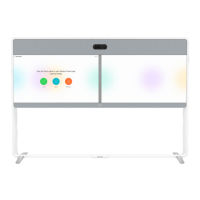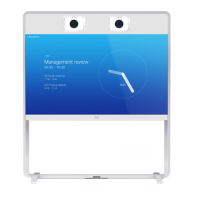
Do you have a question about the Cisco MX300 G2 and is the answer not in the manual?
| Microphone | Integrated microphone array |
|---|---|
| Connectivity | Ethernet, HDMI, USB |
| Frame Rate | 60 fps |
| Protocols | SIP, H.323 |
| Video Conferencing Support | Yes |
| Operating System | Cisco Collaboration Endpoint Software |
| Camera | PrecisionHD Camera 1080p |
| Display | 27-inch LCD |
| Control | Touchscreen controller |
| Product Type | Video conferencing system |
| Video Standards | H.264, H.265 |
| Power | 100-240 VAC, 50/60 Hz, 12.5 A |
Essential guidelines for effective and professional video conferencing etiquette and setup.
Tips for ease of use, camera presets, loudspeaker volume, and brightness control.
Navigating and understanding the functions of the touch screen interface.
Managing Do Not Disturb, standby mode, and logging into the system.
Steps to sign into the system using personal login details.
How to initiate a call using entries from the contact list.
Modifying contact details before making a call.
Methods to make calls by entering contact names or IP addresses.
How to make a call by dialing a phone number.
How to answer, decline, or ignore incoming calls.
Managing incoming calls when already in an active call.
Procedures for transferring calls to another party.
How to consult with a party before transferring a call.
Steps to end your participation in a call or conference.
Guidance on microphone usage and privacy indicators.
How to place a call on hold and then resume it.
How to adjust the call's bandwidth allocation for quality.
Enabling Do Not Disturb and Standby modes.
How to add new participants to an ongoing conference call.
Merging an incoming call into an existing conference call.
Viewing, managing participants, and customizing call screen layouts.
Fixing speaker view and removing participants from a conference.
Procedures for initiating and ending content sharing.
How to adjust the screen layout during presentations.
Accessing, viewing, and joining scheduled meetings.
Extending meeting duration and joining meetings with reminders.
Handling multiple meetings occurring simultaneously.
Accessing and using the corporate directory for contact information.
Viewing and managing the list of recent calls.
Managing a personalized list of frequently called contacts.
How to add contacts to Favorites during an active call.
Accessing and adjusting camera controls like zoom, pan, and tilt.
Creating custom camera views (presets) for quick access.
Controlling selfview, resizing, moving, and controlling other participant cameras.
Accessing main settings, sound, camera, display, source, language, system info, call status, diagnostics, and restart.
Steps to access administrator settings, typically password-protected.
Configuring date/time, call details, and provisioning wizard.
Settings for network (IP/VLAN), multipoint, SIP, and H323.
Network status, EMC resilience, web snapshots, and factory reset options.











